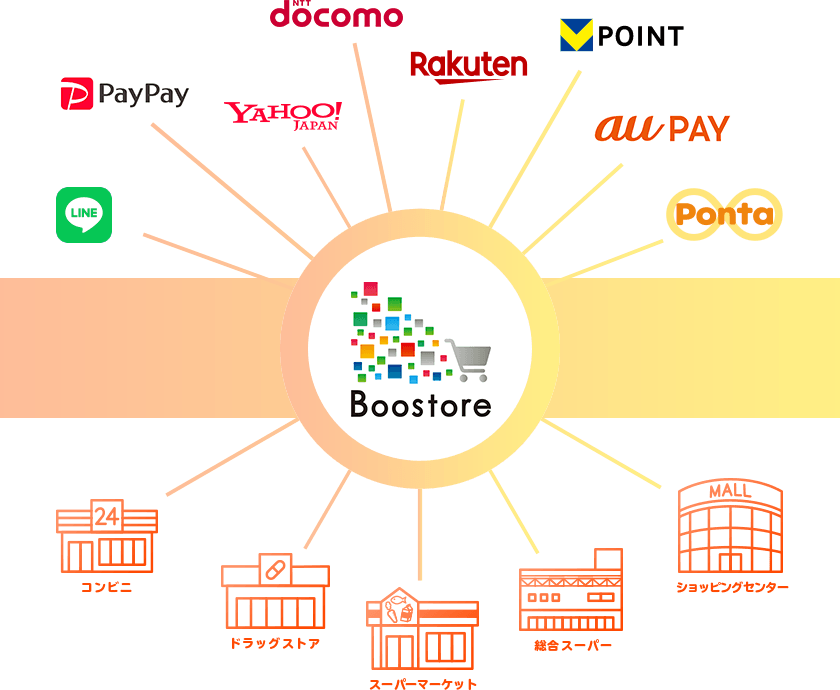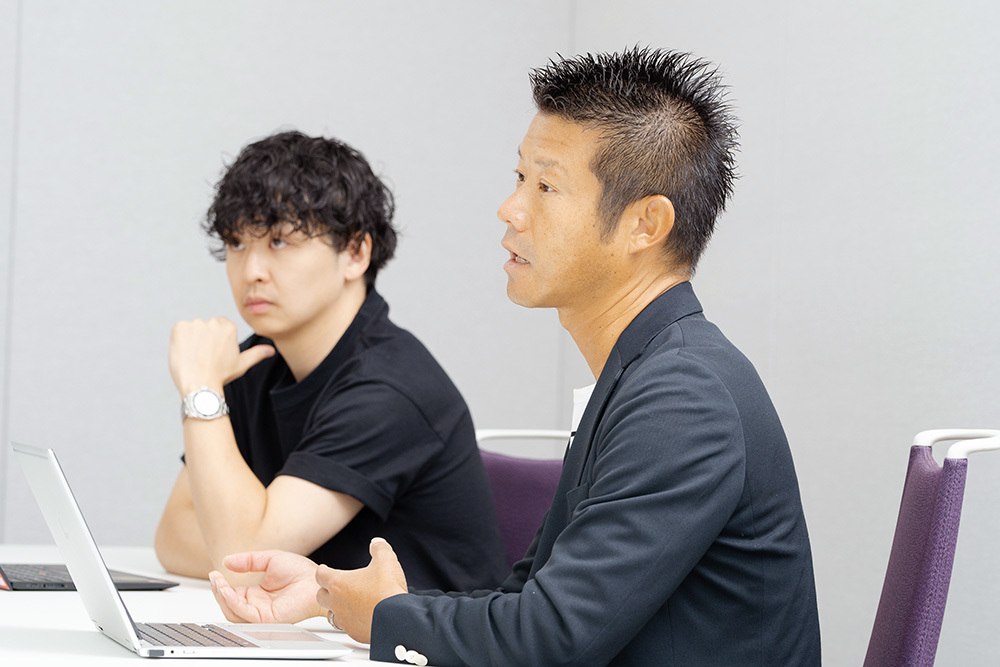In recent years, digital promotions leveraging ID data from major platform providers have significantly evolved as a key strategy for "in-store promotions," which have grown increasingly important, particularly for FMCG (Fast-Moving Consumer Goods) manufacturers.
However, many companies likely face challenges such as "being unable to keep up with rapidly changing trends" or "wanting to take on new challenges but not knowing where to start."
To address these challenges, Dentsu Inc., Dentsu Digital Inc., and DENTSU PROMOTION PLUS INC. established the digital sales promotion team " Boostore." They are now helping various clients select the optimal platform providers and deliver solutions for their sales promotion needs.
Now, Boostore team members discuss the current challenges and needs in in-store promotions and the new trends in digital promotions that can solve them.

(From left) Hiro Kunibo, Dentsu Digital Inc. / Yasutaka Okada, Dentsu Inc. / Kazuki Nagata, DENTSU PROMOTION PLUS INC.
Growing Demand for Sales-Driven Initiatives
──First, please tell us about the challenges companies currently face with in-store promotions.
Okada: Traditional in-store promotions often lacked sufficient verification of their impact on sales at the point of sale. In a sense, it was a case of "doing it and leaving it at that" – the assets gained through a campaign were frequently not leveraged for the next one.
However, recent advancements in digital promotions utilizing platforms like LINE and PayPay, along with the evolution of retail media, now enable measurement of in-store sales impact and the reuse of accumulated campaign assets. For example, it's now possible to present new offers to customers who participated in the previous campaign. This shift represents a change in marketing trends from a flow-based to a stock-based model. Whether a company can adapt to these new trends significantly impacts the quality of its promotions.
──So there's a potential for a significant gap to emerge between companies that can adapt to these new marketing trends and those that cannot?
Okada: Yes, that's correct. While I believe only a limited number of companies are currently implementing these approaches proactively, even among those starting to address this, there seems to be considerable variation in the depth of their response.
──For example, what kinds of points are becoming bottlenecks?
Okada: Ideally, you need to develop plans that match the platform's characteristics and compatibility with the actual consumers shopping in-store and the products you want to promote.
However, the reality is that the diversification of platforms has led to a lack of knowledge and know-how about each specific platform. This makes it difficult to determine which of the many available tactics to choose.
──Could you give a concrete example of the kinds of needs you hear from clients regarding in-store promotions?
Nagata: Simply put, there's a very high demand for initiatives that directly contribute to "in-store sales." In recent years, there's been a growing impression that experience design is required – one that includes the shopping experience, such as brand experiences and usability within campaigns – to contribute to in-store sales.
──Are there any particularly striking changes in client needs you've observed?
Nagata: In campaigns from a few years ago, we often received requests seeking so-called "buzz," and it felt like sales promotion and buzz were discussed on the same level. Recently, I think more clients have started clearly separating the roles: initiatives aimed at creating buzz and initiatives committed to driving in-store sales.
Okada: Precisely measuring whether buzz directly translates to sales can be difficult, so there's a growing trend toward demanding initiatives where the effectiveness can be clearly visualized.
Nagata: That's right. While there's still demand for buzz-driven initiatives, I think we're shifting away from the mindset that "if it goes viral, it will sell" towards recognizing that "buzz and sales are separate entities."
──Given that, it seems the cost-effectiveness of initiatives will be scrutinized even more closely.
Nagata: Exactly. Since KPIs/KGIs for sales tied to initiatives are becoming clearer, the demand for not only cost-effectiveness but also simulations based on historical data is skyrocketing. From that perspective too, digital promotions that enable data analysis and utilization are gaining significant attention.
Proposing optimal strategies tailored to product characteristics and needs, platform- and channel-agnostic
──First, could you explain what "digital promotion" actually is, its definition and effectiveness?
Kunihiro: We use the term "digital promotion" to collectively refer to sales promotions that leverage ID data from various platform providers. The key feature of digital promotion is its ability to easily enable continuous, ongoing, stock-based marketing. By accumulating ID data through campaigns, we can visualize the effectiveness of initiatives and implement continuous approaches to customers who have participated once.
Boostore, a cross-organizational initiative within the Dentsu Group in Japan, works to develop and propose comprehensive solutions. Starting with this digital promotion, Boostore aims to solve clients' marketing challenges in the storefront and sales promotion domains.
──What exactly does "comprehensive solution development and proposal" entail?
Kunihiro: We can plan platform-agnostic solutions based on various data, tailored to each client's specific challenges. The Dentsu Group in Japan has a proven track record of supporting diverse clients and maintains strong relationships with various platform providers. This allows us to propose optimal strategies based on the client's product characteristics and needs, without being constrained by specific platforms or tactics.
──I see. That seems like a significant differentiator among the many digital sales promotion support services available.
Nagata: Yes. Furthermore, to implement these strategies, we provide original digital solutions, simulation tools, and data analysis tools, including our own proprietary technologies. Additionally, by combining platform-owned data with consumer awareness survey results and other data held by Dentsu Inc., we can achieve more advanced data analysis and utilization.
Okada: Furthermore, rather than simply providing customers with cost-effective measures, our ability to design experiences that include new shopping experiences is another point where the creativity unique to the Dentsu Group in Japan truly shines.
──You mentioned a cross-functional organization. Could you elaborate on the team's scale and composition?
Okada: Dentsu Inc. supports clients by understanding product characteristics and providing comprehensive marketing strategy support beyond digital promotions. DENTSU PROMOTION PLUS INC. excels in developing solutions to implement strategies based on that planning. Dentsu Digital Inc. maintains strong relationships with media companies. While each company has its own areas of expertise, we currently operate as one integrated team without barriers.
We have a diverse team of around 100 highly skilled members with varied backgrounds—researchers, planners, data scientists, and specialists from manufacturers, retailers, and distributors. We assemble the optimal team for each project.
We aim to solve point-of-sale promotion challenges centered around four solutions
──Could you briefly explain what solutions you use to tackle client challenges?
Okada: We offer various solutions, starting with our four original ones: " Apply via LINE," which can be used throughout the entire campaign scheme; " SCAN DA CAN " and " I Bought It Flag " for purchase verification; and " SP COMPASS," a simulation and ad delivery optimization tool.
Kunihiro: "Apply via LINE" is a solution we can provide as one of only three companies in Japan designated as a LINE Yahoo "Technology Partner." It supports comprehensive promotions utilizing LINE's official accounts and we believe it can also contribute to increasing "friend registrations" on clients' LINE official accounts.
Nagata: "SCAN DA CAN" is a new purchase verification solution leveraging AI technology. Simply photographing products like cans with a smartphone camera provides proof of purchase, enabling campaign entry. Compared to traditional entry methods using receipts or QR codes, it enables effortless entry within a natural brand experience.
"I Bought It Flag" assigns a barcode to customers who pre-register, allowing them to receive various in-store promotional incentives. Since there's no need to manage paper coupons or receipts, it provides a user experience perfectly suited for the cashless era.
Okada: "SP COMPASS" is a simulation tool that enables predicting the effectiveness of digital promotional campaigns based on data from various platform providers. It also features the ability to deliver ads specifically to individuals showing high intent to participate in campaigns.
It's crucial to create not just savings, but the "joy of shopping."
──We'd like to hear more about specific use cases for each solution next time. Finally, could you share any trends you're watching or your vision for how in-store promotions will evolve in the future?
Kunihiro: As mentioned earlier, more customers are shopping without physical wallets, leading to the rapid proliferation of diverse electronic payment services. The deeper cashless adoption penetrates, the more critical it becomes to leverage platformer ID data for promotions.
At that point, I believe the key will be "how to create enjoyable shopping experiences." It's not just about offering discount services; it's about providing experiences that align with the fun and excitement of shopping itself. This is where creativity becomes essential once again.
Since "frictionless" experiences—pursuing seamless convenience—are expected to become commoditized, I believe creative planning that boosts customer motivation will become essential.
Okada: That's right. Providing customers with enjoyable experiences not only contributes to sales but also builds brand loyalty and fosters fanbase growth. From this perspective, digital in-store promotions hold significant potential.
Nagata: Platform providers are constantly evolving, so I expect new services and systems will continue to emerge, transforming the customer shopping experience. It's crucial to keep pace with these changes and collaboratively develop new strategies with platform providers. This is an area the Boostore team will focus on!
*Next time, we'll delve into the latest case studies of digital promotions.
[Business Inquiries]
Boostore Official Site: https://boostore.jp











